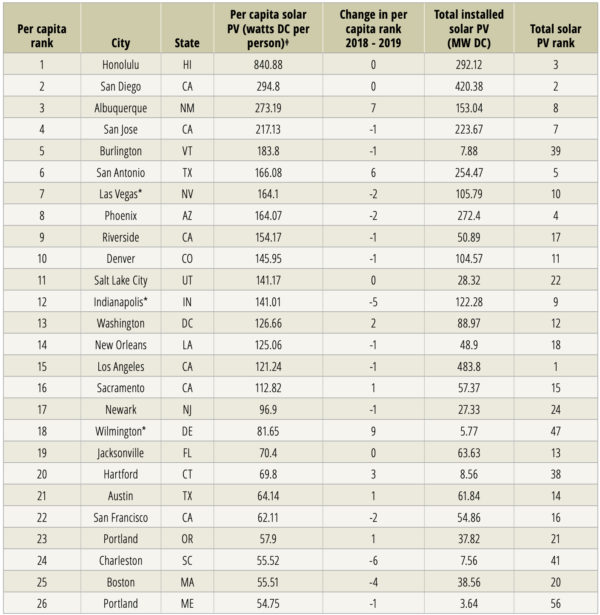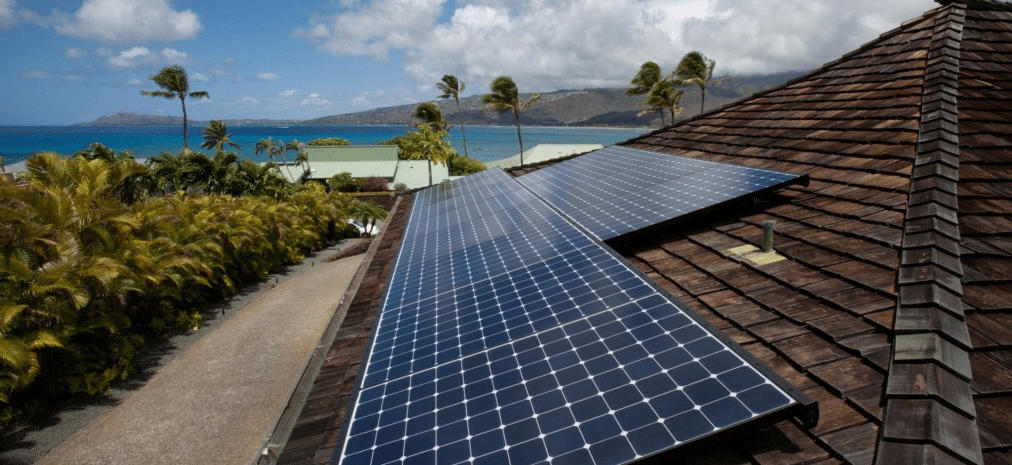Twenty-six U.S. cities have at least 50 watts of PV per capita—and they’re not all in the sunniest states.
Honolulu is in a league of its own, with 841 watts of PV per capita, as a study from the nonprofit Environment Texas reports. San Diego, with 295 watts per capita, leads the rest of the pack.
While the list of 26 cities is dominated by cities in California and the Southwest, 12 far-flung cities also make the cut, from Burlington and Newark in the Northeast, to Jacksonville and Charleston in the Southeast, to Indianapolis in the Midwest.
For suburbs looking to join the race, the report adds that the small community of Palm Springs, California has 790 watts of PV per person.
PV-friendly
More than 150 cities have set a goal to power city operations with 100% renewable electricity, says the report.
The report presents several options for these cities and others to also support rooftop PV installations. City officials can look to Chattanooga’s work to speed solar permitting. They can enact property-assessed clean energy (PACE) financing for rooftop solar, as El Paso, Texas has done. They can install solar on public buildings, and modify ordinances to allow energy storage and electric vehicle charging.
Following Tucson’s lead, cities can require new homes to either include solar, or be solar-ready, the report adds. Cities can enact solar access ordinances “to protect residents’ right to generate solar energy on their own property.” And they can work together with other cities to influence state policy.
1,118 GW
“U.S. cities have only begun to tap their solar energy potential,” says the report, citing rooftop solar’s technical potential of 1,118 GW, as estimated by the National Renewable Energy Laboratory (NREL). Since NREL published its estimate in 2016, solar panel efficiencies have increased, which suggests a higher technical potential today.
The report’s authors say that some of the 70 cities included in the report “could generate hundreds of times more solar power than they do today.” Phoenix, Chicago, San Diego, Oklahoma City and Dallas “could each install more than 2,000 MW of solar PV capacity on small rooftops alone,” they say, citing the NREL study.
Los Angeles, with 121 watts of PV per capita, could host ten times more solar just on small building rooftops, say the authors, citing a U.S. Department of Energy study. But Washington, DC is setting the pace on meeting its potential, the authors say, citing the same DOE study, as the city has met “over a quarter” of its potential for siting PV on small buildings.
San Antonio could reach more than 6,200 MW of solar on its rooftops, the authors add, citing two sources.
The Environment Texas report obtained data for the core city within each of the nation’s 50 most populous metropolitan areas. For states not yet represented in that list of 50 cities, the analysis includes each state’s largest city. To compile the data, analysts sifted through separate data sources for each of the resulting 70 cities.
The 50 watts per capital value that is exceeded by 26 cities is not far below the U.S. national average of 70 watts of small-scale PV per capita. Cities are at a disadvantage to the nation as a whole in attaining a high level of PV per capita, as cities have taller buildings with less roof space per resident, while ground-mounted systems that are only economical in rural areas boost the national average.
The report “Shining Cities 2020” also presents data for 200 communities in Texas. A section on cities with municipal utilities offers additional policy options. The report’s authors are Adrian Pforzheimer and Elizabeth Ridlington of Frontier Group, and Ben Sonnega and Emma Searson of Environment America.
Here’s the report’s table of the 26 cities with at least 50 watts of solar per capita:

This content is protected by copyright and may not be reused. If you want to cooperate with us and would like to reuse some of our content, please contact: editors@pv-magazine.com.








“The report’s authors say that some of the 70 cities included in the report “could generate hundreds of times more solar power than they do today.” Phoenix, Chicago, San Diego, Oklahoma City and Dallas “could each install more than 2,000 MW of solar PV capacity on small rooftops alone,” they say, citing the NREL study.”
The NREL study released a couple of years ago used LIDAR to detect “viable” solar PV harvest roof spaces in the U.S.. It was determined that 67.2 million roofs could be used to harvest solar PV across the U.S.. At an “average” of 6kWp on each roof for 4 sun hours average per day, you’d have 161.3 GWh a day. In the Southwest it would probably on average be more and in the Northeast 4 sun hours may be just about right on “average”. With solar PV panel offerings of around 360 watts per panel, a 400 square foot roof space could generate 7.92kWp for 4 hours and 67.2 million roofs generate about 213 GWh a day.
“The 50 watts per capital value that is exceeded by 26 cities is not far below the U.S. national average of 70 watts of small-scale PV per capita. Cities are at a disadvantage to the nation as a whole in attaining a high level of PV per capita, as cities have taller buildings with less roof space per resident, while ground-mounted systems that are only economical in rural areas boost the national average.”
I’ve read some papers that say “Perovskites” are the solar PV chemistry of the future. Other papers say tandem either Perovskite or hybrid crystalline solar cell with a ‘coating’ of perovskite sprayed or printed on the crystalline solar cell could create the 40% solar PV cell within 5 years. IF that becomes true, consider 67.2 million roofs with 15.84kWp on each roof for 4 sun hours average each day. An average of 426 GWh a day and an average of what 155 TWh a year. It seems like this NREL study is just area times number of valid solar PV roofs that would generate power. Take into account the area of solar PV allowed at big box stores, warehouses, commercial buildings, industrial complexes often with very large roof spaces and a lot of parking that could be covered with solar PV also. When distributed solar PV is used in this fashion, it goes far and beyond the raw generation numbers on average, it gets rid of intrinsic grid losses which represents in costs to get power to the ratepayer through grid losses. More power generated locally to use and less power loss getting the product to market. It could save something like 6% to 9% power loss easily by generating power on the roof of the building that will use the power, save overgeneration on site and extend the self consumption of solar PV into the evening give one another few percentage points due to extending the solar PV harvest day.
The 2016 NREL paper on solar rooftop technical potential had 1,432TWh generated using 1,118GW of capacity across 8,130 million m^2. This was across all building types. This would be about 35% of 2019 electric generation.
It’s not could but when. And when is next yr when systems cut to the $1.75/wt level as the incompetent one’s tariffs go away.
Nor is PACE a good idea as incumbers the house causing many cities, etc to refuse it.
With the cost so low and reliable now NGOs both get discounts for bringing in customers and arrange or give low cost loans.
I’ll be using them to sell my solar sheds, patios, carports at $1.50/wt now and $1/wt after tariffs are gone and back to world pricing.